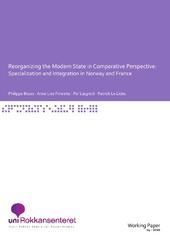| dc.contributor.author | Bezes, Philippe | eng |
| dc.contributor.author | Fimreite, Anne Lise | eng |
| dc.contributor.author | Lægreid, Per | eng |
| dc.contributor.author | Le Lidec, Patrick | eng |
| dc.date.accessioned | 2012-01-10T10:25:33Z | |
| dc.date.accessioned | 2020-12-10T06:31:32Z | |
| dc.date.available | 2012-01-10T10:25:33Z | |
| dc.date.available | 2020-12-10T06:31:32Z | |
| dc.date.issued | 2010-12 | eng |
| dc.identifier.issn | 1503-0946 | |
| dc.identifier.uri | https://hdl.handle.net/1956/5392 | |
| dc.description | This paper was presented at the IPSA’s Research Committee 29 on the Structure and Organization of Government (SOG) conference "Crisis as Opportunity: State, Markets and Communities in Turbulent Times". Hertie School of Governance, Berlin 4–5 November 2010. Philippe Bezes and Patric Le Lidec is form the National Center for Scientific Research (CNRS, CERSA), Paris. Anne Lise Fimreite and Per Lægreid come from Uni Rokkansenteret and the University of Bergen. The French data have been collected within a research programme, funded by the French National Agency for Research (ANR), and running rom 2009 ro 2012 Project ANR 08-GOUV-040. | en |
| dc.description.abstract | Administrative systems have historically always been confronted with issues of integration and coordination on the one hand and autonomy and fragmentation on the other hand. The main topic of this paper is the challenge Norway and France face in coordinating specialized government activities after ten years of comprehensive reforms. We will consider the transformation of the French and Norwegian administrative architecture brought about by the reforms since the early 2000s and the choices the two countries have made with respect to multi-level governance. The focus is on the tension between territorial and sectoral specialization and between vertical and horizontal specialization as well as on how coordination has been reintroduced by hierarchy and other means. We describe both sector-specific administrative reforms and more overarching general administrative reforms, looking at similarities and differences in the reorganization choices made by the two countries and also at what drives change. We argue that a combination of factors are required to explain outcomes rather than eitheror explanations These factors include not only home-grown reforms, but also sectoral challenges, diffusion and learning from abroad, adaptation to the financial crisis and budget deficit and the free choices made by powerful political executives. Sometimes these factors work together and reinforce each other, producing radical reforms; at other times they have a mutually constraining influence, resulting in only minor changes. Empirical reality in various countries thus offers a marked contrast to all-encompassing ideas like "generic" public management, "global recipes" and simple models of administrative reforms. | en_US |
| dc.description.abstract | Administrative system har alltid stått overfor spenninger mellom på den ene side integrering og samordning og på den andre side autonomi og fragmentering. Hovedtemaet i dette notatet er de utfordringer som Norge og Frankrike møter når det gjelder å samordne spesialiserte statlige aktiviteter etter ti år med omfattende reformer. Vi fokuserer på ombyggingen av den norske og franske administrative arkitekturen gjennom en rekke reformer siden tidlig på 2000 tallet og hvilke valg som er gjort når det gjelder flernivå-styring. Spenningen mellom territoriell og sektoriell spesialisering og mellom vertikal og horisontal spesialisering står sentralt samtidig som oppmerksomheten rettes mot hvordan man tar ulike samordningsformer i bruk. Vi beskriver både likheter og forskjeller i sektorspesifikke forvaltningsreformer og mer overgripende generelle reformer samtidig som de drivkrefter som ligger bak endringene analyseres. Vårt argument er at en-faktor forklaringer er utilstrekkelig og at det er behov for å kombinere flere forhold for å forstå reformprosessene. Reformene kan ikke bare forstås som hjemmelagede, men også sektorielle utfordringer, diffusjon og læring fra utlandet, tilpasning til finanskrise og budsjettunderskudd og bevisste valg fra et sterkt politisk lederskap påvirker innholdet i reformene. Noen ganger virker slike faktorer sammen og produserer radikale reformer, men i andre tilfelle kan de motvirke hverandre og føre til bare mindre endringer. Det er imidlertid klare forskjeller mellom landene i hvor viktig de ulike faktorene er. De empiriske realitetene i de to landene representerer en klar kontrast til globale oppskrifter, likeretting og konvergens mot enkle og sammenfallende administrative modeller. | en_US |
| dc.language.iso | eng | eng |
| dc.publisher | Stein Rokkan Centre for Social Studies | eng |
| dc.relation.ispartofseries | Working Paper | en |
| dc.relation.ispartofseries | 14-2010 | en |
| dc.title | Reorganizing the Modern State in Comparative Perspective: Specialization and Integration in Norway and France | eng |
| dc.type | Working paper | eng |
| dc.rights.holder | Copyright Stein Rokkan Centre for Social Studies. All rights reserved | |
| dc.subject.nsi | VDP::Samfunnsvitenskap: 200 | nob |
